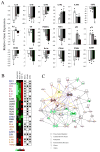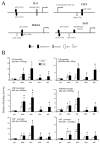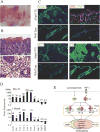ΔNp63 versatilely regulates a Broad NF-κB gene program and promotes squamous epithelial proliferation, migration, and inflammation
- PMID: 21576089
- PMCID: PMC3443863
- DOI: 10.1158/0008-5472.CAN-10-3445
ΔNp63 versatilely regulates a Broad NF-κB gene program and promotes squamous epithelial proliferation, migration, and inflammation
Erratum in
- Cancer Res. 2011 Dec 1;71(23):7323
Abstract
Head and neck squamous cell carcinoma (HNSCC) and many other epithelial malignancies exhibit increased proliferation, invasion, and inflammation, concomitant with aberrant nuclear activation of TP53 and NF-κB family members ΔNp63, cRel, and RelA. However, the mechanisms of cross-talk by which these transcription factors coordinate gene expression and the malignant phenotype remain elusive. In this study, we showed that ΔNp63 regulates a cohort of genes involved in cell growth, survival, adhesion, and inflammation, which substantially overlaps with the NF-κB transcriptome. ΔNp63 with cRel and/or RelA are recruited to form novel binding complexes on p63 or NF-κB/Rel sites of multitarget gene promoters. Overexpressed ΔNp63- or TNF-α-induced NF-κB and inflammatory cytokine interleukin-8 (IL-8) reporter activation depended on RelA/cRel regulatory binding sites. Depletion of RelA or ΔNp63 by small interfering RNA (siRNA) significantly inhibited NF-κB-specific, or TNF-α-induced IL-8 reporter activation. ΔNp63 siRNA significantly inhibited proliferation, survival, and migration by HNSCC cells in vitro. Consistent with these data, an increase in nuclear ΔNp63, accompanied by increased proliferation (Ki-67) and adhesion (β4 integrin) markers, and induced inflammatory cell infiltration was observed throughout HNSCC specimens, when compared with the basilar pattern of protein expression and minimal inflammation seen in nonmalignant mucosa. Furthermore, overexpression of ΔNp63α in squamous epithelial cells in transgenic mice leads to increased suprabasilar cRel, Ki-67, and cytokine expression, together with epidermal hyperplasia and diffuse inflammation, similar to HNSCC. Our study reveals ΔNp63 as a master transcription factor that, in coordination with NF-κB/Rels, orchestrates a broad gene program promoting epidermal hyperplasia, inflammation, and the malignant phenotype of HNSCC.
©2011 AACR
Conflict of interest statement
Figures







Similar articles
-
Epidermal overexpression of transgenic ΔNp63 promotes type 2 immune and myeloid inflammatory responses and hyperplasia via NF-κB activation.J Pathol. 2014 Feb;232(3):356-68. doi: 10.1002/path.4302. J Pathol. 2014. PMID: 24258200
-
TNF-α modulates genome-wide redistribution of ΔNp63α/TAp73 and NF-κB cREL interactive binding on TP53 and AP-1 motifs to promote an oncogenic gene program in squamous cancer.Oncogene. 2016 Nov 3;35(44):5781-5794. doi: 10.1038/onc.2016.112. Epub 2016 May 2. Oncogene. 2016. PMID: 27132513 Free PMC article.
-
Dysregulation of junctional adhesion molecule-A via p63/GATA-3 in head and neck squamous cell carcinoma.Oncotarget. 2016 Jun 7;7(23):33887-900. doi: 10.18632/oncotarget.8432. Oncotarget. 2016. PMID: 27036044 Free PMC article.
-
Role of activated nuclear factor-kappaB in the pathogenesis and therapy of squamous cell carcinoma of the head and neck.Head Neck. 2007 Oct;29(10):959-71. doi: 10.1002/hed.20615. Head Neck. 2007. PMID: 17405170 Review.
-
Molecular Mechanisms of p63-Mediated Squamous Cancer Pathogenesis.Int J Mol Sci. 2019 Jul 23;20(14):3590. doi: 10.3390/ijms20143590. Int J Mol Sci. 2019. PMID: 31340447 Free PMC article. Review.
Cited by
-
An intronic SNP affects skeletal muscle development by regulating the expression of TP63.Front Vet Sci. 2024 Jun 12;11:1396766. doi: 10.3389/fvets.2024.1396766. eCollection 2024. Front Vet Sci. 2024. PMID: 38933706 Free PMC article.
-
A pyroptosis gene-based prognostic model for predicting survival in low-grade glioma.PeerJ. 2023 Nov 13;11:e16412. doi: 10.7717/peerj.16412. eCollection 2023. PeerJ. 2023. PMID: 38025749 Free PMC article.
-
Squamous trans-differentiation of pancreatic cancer cells promotes stromal inflammation.Elife. 2020 Apr 24;9:e53381. doi: 10.7554/eLife.53381. Elife. 2020. PMID: 32329713 Free PMC article.
-
ΔNp63α enhances the oncogenic phenotype of osteosarcoma cells by inducing the expression of GLI2.BMC Cancer. 2014 Aug 1;14:559. doi: 10.1186/1471-2407-14-559. BMC Cancer. 2014. PMID: 25085524 Free PMC article.
-
Unraveling regulatory programs for NF-kappaB, p53 and microRNAs in head and neck squamous cell carcinoma.PLoS One. 2013 Sep 19;8(9):e73656. doi: 10.1371/journal.pone.0073656. eCollection 2013. PLoS One. 2013. PMID: 24069219 Free PMC article.
References
-
- Karin M. Nuclear factor-kappaB in cancer development and progression. Nature. 2006;441:431–6. - PubMed
-
- Stiewe T. The p53 family in differentiation and tumorigenesis. Nat Rev Cancer. 2007;7:165–8. - PubMed
-
- Dey A, Tergaonkar V, Lane DP. Double-edged swords as cancer therapeutics: simultaneously targeting p53 and NF-kappaB pathways. Nat Rev Drug Discov. 2008;7:1031–40. - PubMed
-
- Van Waes C. Nuclear factor-kappaB in development, prevention, and therapy of cancer. Clin Cancer Res. 2007;13:1076–82. - PubMed
-
- Tergaonkar V, Pando M, Vafa O, Wahl G, Verma I. p53 stabilization is decreased upon NFkappaB activation: a role for NFkappaB in acquisition of resistance to chemotherapy. Cancer Cell. 2002;1:493–503. - PubMed
Publication types
MeSH terms
Substances
Grants and funding
LinkOut - more resources
Full Text Sources
Other Literature Sources
Medical
Molecular Biology Databases
Research Materials
Miscellaneous

